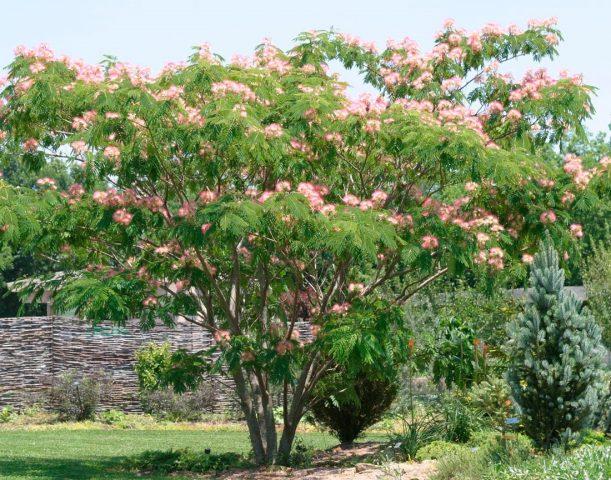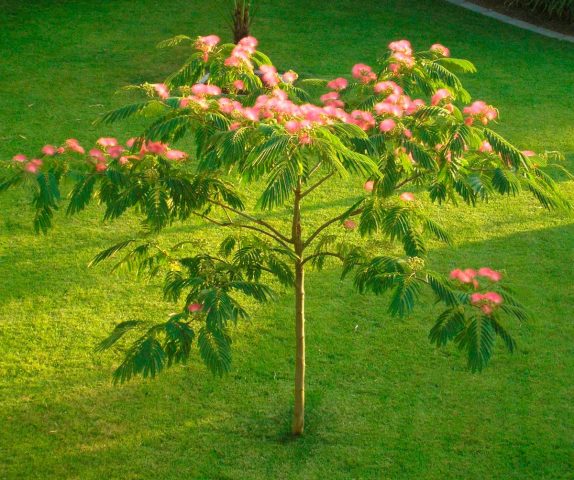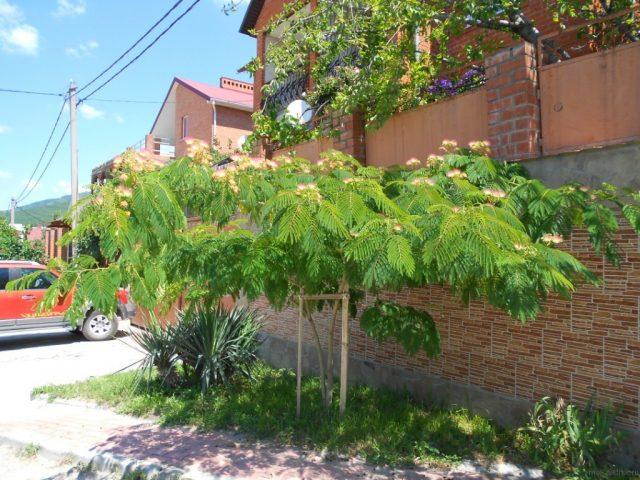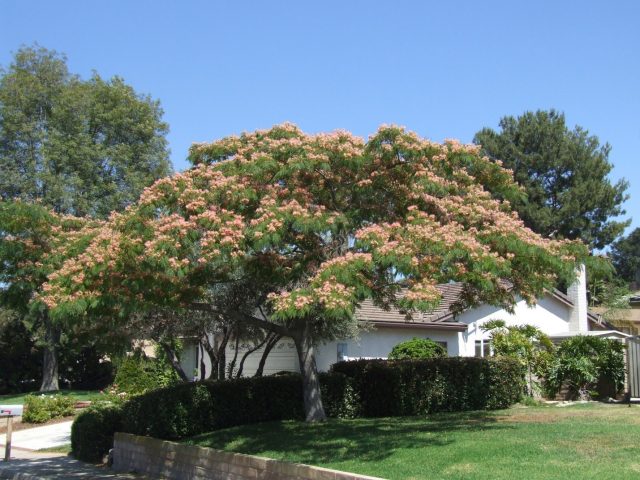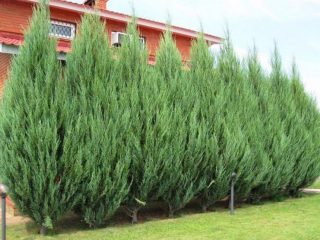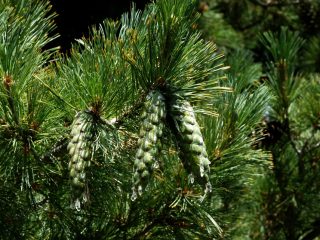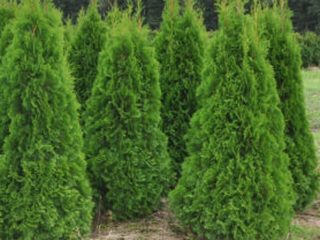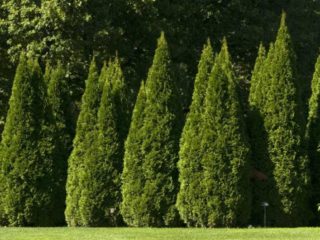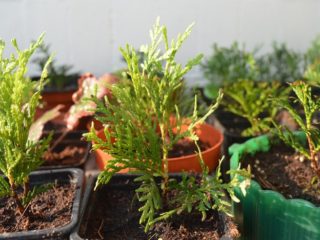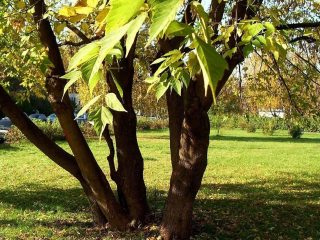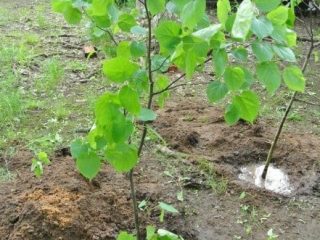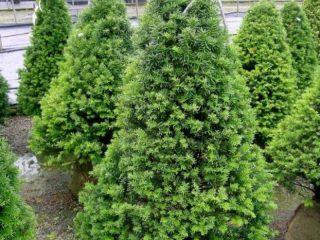Content
Lankaran acacia is one of the most beautiful trees with large openwork leaves and pleasant pinkish flowers. Found naturally in warm subtropical countries. Under certain conditions, it is possible to grow a tree in Russia. How to do this is described in detail in the article.
Description and photo of Lankaran acacia
Lenkoran albizia, which is also called Crimean acacia, belongs to the genus Albizia from the legume family. It forms an independent biological species, named after the Italian Filippo del Albizzi, who first described the plant in the mid-18th century.
Acacia is a medium-sized tree, reaching a height of 7-9 m. Less often, it can stretch up to 13-16 m. The crown is spreading, umbrella-shaped, openwork thanks to small leaves. It reaches 6-7 m in width, so it looks especially attractive.
Albizia Lankaran is classified as an ornamental tree.The foliage is unpaired, bipinnate, consists of several lobes (from 9 to 15), each of which has 15-30 pairs of small leaves. Attached using secondary roots. The color of the upper side is rich green, the lower side is lighter.
The leaves reach 20 cm in length - the photo of the southern acacia shows that they are quite large, symmetrical, and regular in shape. Interestingly, every night the leaves fold in half lengthwise relative to the midrib. At the same time, the plate itself droops, as if withering. Exactly the same picture is observed on hot days. In late autumn the foliage turns yellow and the tree sheds it.
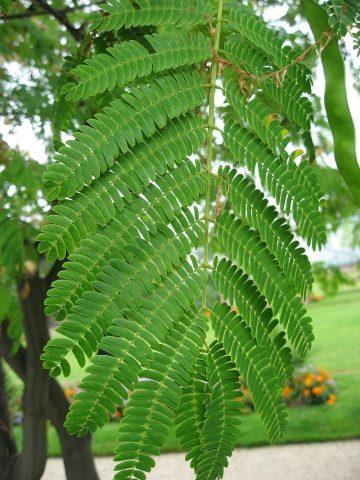
Lenkoran acacia is decorative thanks to its beautiful graceful leaves
Flowering continues throughout the summer, after which Lankaran acacia bears fruits, represented by multi-seeded beans. Initially they are green in color, then turn yellow and partly turn brown. The shape is flat, length is from 10 to 20 cm. The seeds of Lankaran acacia are oval in shape, also flat. The color is light brown or brown. The seeds reach 7 mm in length.
Application of acacia
Lankaran acacia is a honey tree. In addition, it is used to obtain wood, and the seeds are used to feed domestic animals. Wild animals also feed on them.
It is also known for its medicinal properties - decoctions are prepared from the flowers and bark of the stems, which help with various diseases and disorders:
- dyspnea;
- insomnia;
- irritability;
- memory problems;
- destruction of parasites in the intestines;
- diuretic;
- anti-inflammatory effect;
- wound healing;
- elimination of edema;
- antidepressant.
Frost resistance of Lankaran acacia
The frost resistance of this tree is low.Its origin is associated with the countries of the subtropical climate zone. In cold winters, even in Georgia and southern Russia, the tree freezes. However, if you arrange a shelter, it is quite possible to grow Lenkoran Albizia in the Moscow region, as well as in other regions of the middle zone.
It is worth considering that the tree can only fully withstand temperatures down to -16 degrees. If it gets colder to -18, this year's young growth will suffer. If there are frosts down to -22, powerful branches of the crown will also be damaged. When the temperature stays at -20 or below for 1.5-2 weeks, all above-ground shoots freeze. At the same time, in spring and summer they begin to recover.
Places of growth
In nature, the tree is found only in the subtropical region. Moreover, the growing area is very extensive and covers a significant part of Asian countries:
- Azerbaijan;
- Türkiye;
- Korea;
- Iran;
- Taiwan;
- Korea;
- Nepal;
- Butane.
The tree is cultivated in some European countries - Moldova and Ukraine. Lankaran acacia can also be found in the United States, in the countries of Central Asia and in many regions of China.
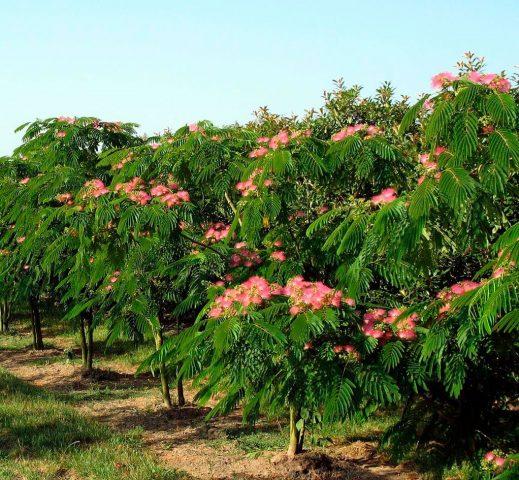
Acacia Lankaran is found in regions with a subtropical climate
When does Lankaran acacia bloom?
The Lenkoran acacia blooms for a very long time, observed from May to August. The color of the inflorescence is white, with a yellowish tint. The flowers growing in the central part of the tree are bisexual, and on the edges they are sterile; they do not produce seeds. The stamens are clearly visible - they are long, colored white or pinkish. In this case, all the buds are organized into inflorescences - corymbose-shaped panicles.
Advantages and disadvantages
Acacia Lankaran is an unusual tree for the Russian climate. It is easy to care for, although it may suffer from frost. The plant has several advantages and disadvantages that you should pay attention to when growing.
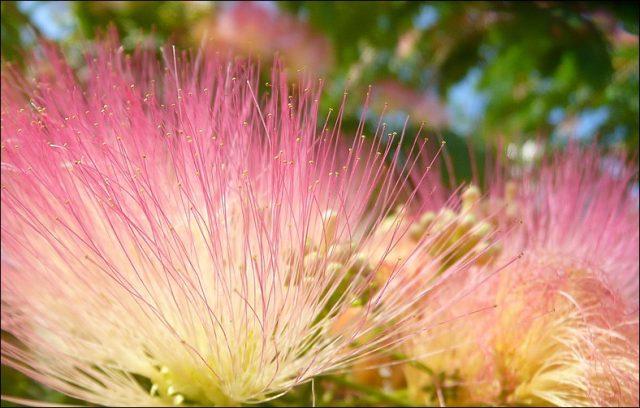
Lankaran acacia inflorescences (enlarged photo)
Pros:
- very beautiful and large foliage;
- spreading crown;
- easy care;
- can be grown both vegetatively and from seeds;
- long flowering;
- honey plant.
Minuses:
- low frost resistance - needs to be covered for the winter;
- may suffer from fungal diseases.
How to grow Lankaran acacia
At home, Lankaran acacia is often grown from seeds. At the end of February they are planted in fertile soil to a depth of no more than 1 cm with an interval of 6-7 cm or more. Cover with film and place on a well-lit windowsill (use additional lighting).
As is the case with seedlings of other plants, the boxes are covered with film, periodically removed and watered with settled water (preferably from a sprayer). After 1-2, and sometimes three weeks, shoots appear. They do not form so quickly even in good conditions, which is quite normal.
When two leaves appear on each sprout, Lenkoran acacia seedlings can be planted in different containers; it is advisable to transplant them into peat pots. Then they water it and after a few days they give it a complex mineral fertilizer, for example, “Baikal” or “Ideal”.
Seedlings are transferred to open ground only at the end of May or at the beginning of June, when the soil warms up well.They are planted in well-lit places, preferably on hills. It is worth considering that the crown extends up to 7 m, so the distance from the hole to the nearest tree, house or other building should be at least 4 m.
To grow a beautiful silk acacia, as in the photo, you should provide normal care, including preparation for the winter. Experienced gardeners recommend adhering to the following rules:
- Young plants need to be watered weekly, but older plants only twice a month.
- Lenkoran acacia is fed three times a year. Before the buds begin to swell, give ammonium nitrate or another fertilizer. During the formation of buds and after flowering, potassium salt and superphosphate are used.
- Formative pruning is carried out every autumn, and sanitary pruning is carried out in early spring. It is necessary to monitor the correct shape of the Lenkoran acacia crown, and also to promptly get rid of frozen, diseased and old branches.
- For the winter, create a shelter from foam sheets or cardboard. The tree trunk circle is carefully mulched with sawdust, hay, leaf litter, and peat. It is advisable to cover the soil itself with plastic film.
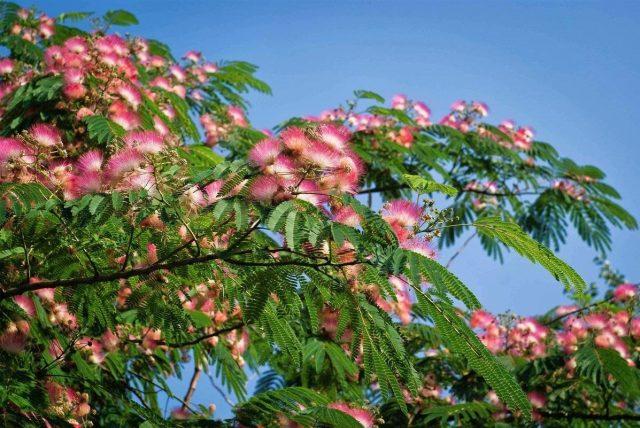
For long flowering, Lankaran acacia is fed three times per season.
Reproduction of Lankaran acacia
There are several ways to propagate this beautiful tree. For example, some gardeners resort to growing Albizia Lankaran from seeds. This is a rather labor-intensive method, but it guarantees that you will get healthy seedlings that will begin to grow in open ground. You can also propagate a tree using vegetative methods - using cuttings and root shoots.
Seeds
Lankaran acacia seedlings grow well even at normal room temperature.But you need to take into account several features:
- Seeds are sown in the last days of February, when there is still not enough natural light. Therefore, mandatory illumination is required - diodes or special phytolamps can be used. They are placed 50 cm above the soil surface in pots.
- Lankaran acacia seeds require preliminary preparation. Each of them is first filed a little in order to partially damage the top layer. Then fill it with water at room temperature for several days. And only after the first shoots appear, they are planted in the prepared soil.
- Lankaran acacia seedlings grow well only in fertile and loose soil. You can prepare the mixture yourself by taking peat, sand and turf soil in a ratio of 2:1:3.
- To avoid the risk of spreading bacterial and fungal infections, the soil mixture is steamed or kept in the freezer for several days.
- Planting containers are washed and rinsed with a pink solution of potassium permanganate.
Cuttings
One of the main ways of propagating Lenkoran acacia is using cuttings. Work begins in early July, the sequence of actions is as follows:
- Cut off young branches and remove at least half of the leaves.
- Make an oblique lower and straight upper cut.
- Place it overnight in a solution of a stimulant, for example, “Zircon” or “Heteroauxin”.
- Next, they are planted in moist and fertile soil, covered with a jar, regularly watered and ventilated.
- For the winter, carefully mulch and cover with agrofibre or, for example, burlap.
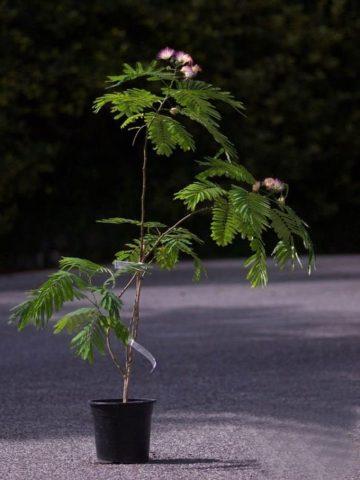
Lankaran acacia cuttings take root in 1.5-2 months
Overgrowth
Mature trees can also be propagated by shoots. The root system of Lankaran acacia is shallow, many roots protrude directly to the surface.At the beginning of summer, they are cut off and soaked overnight in a growth stimulant, after which they are planted in fertile soil, intensively watered and fed. For the winter, carefully cover with mulch and agrofibre.
Diseases and pests
To successfully grow Lankaran acacia, you should take preventive measures against diseases and pests:
- fusarium;
- spider mite;
- Scale insects.
To prevent fungal infections, every spring they are treated with fungicides, for example, Bordeaux mixture, Maxim, Ridomil Gold. Insecticides that help against insects are “Decis”, “Colorado”, “Inta-Vir” and others.
Photos in landscape design
The tree is quite large and spreading, so it looks beautiful in single plantings. It looks especially beneficial on lawns. Under the crown of acacias you can put a bench or create a flower bed with shade-loving plants.
Several options for using wood in garden design are shown below:
- Single planting in an open area.
- Planting on the lawn.
- Lenkoran acacia near the house.
- Another option for planting next to a living space.
Conclusion
Lankaran acacia is not the easiest tree to prepare for winter. Frost resistance is low, so mandatory shelter is required. However, it is unpretentious in care and reproduces in all available ways. Therefore, if you wish, you can grow such an acacia even in central Russia.
